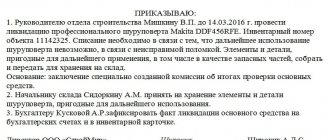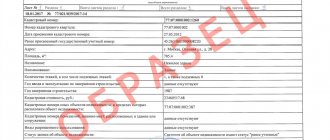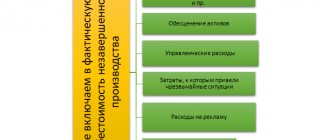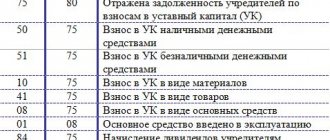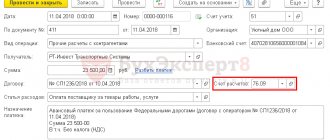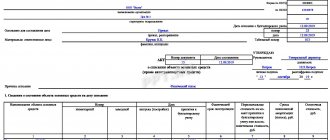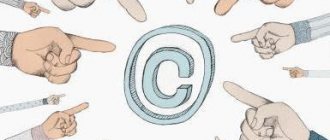Conditions for classifying an instrument as a fixed asset
Tools and inventory can be taken into account as inventories or fixed assets. An inventory item in accounting refers to fixed assets while the following conditions are met: (click to expand)
- Items are intended to be used in the activities of the enterprise to generate income;
- The object is not intended for subsequent resale;
- The service life of the objects is more than 12 months.
The absence of any of the conditions determines accounting as inventory and write-off of tool wear by transferring the cost to expenses when releasing accounting units into production. For tax purposes, classifying an instrument as a fixed asset is possible if the cost of acquisition costs exceeds 100,000 rubles. Accounting for inventory as a fixed asset is carried out using the OS-1 act and the C-6 card.
Systematization of accounting
valid at the time of publication of the material on May 25, 2016. (You should check the official websites for changes and additions.) VI. Disposal of fixed assets 75. The cost of an item of fixed assets that is disposed of or is not constantly used for the production of products, performance of work and provision of services, or for the management needs of the organization, is subject to write-off from accounting.
76. The disposal of an item of fixed assets is recognized in the accounting records of the organization on the date of the one-time termination of the conditions for their acceptance for accounting given in “clause 2” of these Guidelines. Disposal of an item of fixed assets may occur in the following cases: sale; write-offs in case of moral and physical wear and tear; liquidation in case of accidents, natural disasters and other emergency situations; transfers in the form of a contribution to the authorized (share) capital of other organizations, a mutual fund;
Tool depreciation: procedure for determining depreciation rates
When registering equipment, tools, inventory, the period of use during which the inventory unit is capable of bringing economic benefits is determined. In accounting, the estimated useful period is determined by the enterprise. It is advisable to check the useful life with the Classifier of objects belonging to a depreciation group used in tax accounting.
Depending on the group, a period of use is established - the implementation of the assigned tasks by the tools. The length of the period affects the rate of deductions. Each of the Classifier groups provides the opportunity for enterprises to set the operating period within a period of several years. Enterprises independently choose the number of years of use within the allotted time period.
Procedure for calculating instrument depreciation
The value of the instrument is transferred monthly until it is completely written off. The amount of annual deductions is determined by the product of the cost of the instrument and the annual depreciation rate. The amount included in the monthly cost is calculated by dividing the annual depreciation amount by 12 - the number of months.
| Basic concepts in accounting | Characteristics of concepts |
| Depreciation | Transferring the cost of the tool to cost throughout the entire period of use |
| Deduction rate | Set based on the type of tool (membership in the group), which determines the service life |
| Amount of deductions | Calculated depending on the calculation method, acquisition cost and annual rate |
The rate of depreciation is expressed as a percentage. Formula for calculating the norm: H = 1 / C x 100%, where C is the number of years of useful use of the tool. The rate of deductions is determined for the instrument for the entire period without changes, except in cases of modernization with an increase in the period of operation.
What signs indicate wear of the cutting tool?
Let us list the signs of destruction of working surfaces.
- Reducing the dimensional accuracy of the resulting parts and products.
- Increasing the roughness of machined surfaces.
- Increased power consumption by equipment.
- The appearance of burrs.
- Too much heat when cutting.
- The appearance and disappearance of iridescent oxide films.
- Loud noise (its level increases noticeably with vibrations caused by wear).
Methods used to calculate depreciation in accounting
At the legislative level in accounting, acceptable methods are enshrined in PBU 6/01. The choice of option is made by the enterprise depending on the economic efficiency of use.
| Usage options | Linear method | Reducing balance | Cumulative (number of years of use) | Production (proportional to production volume) |
| Characteristic | The cost is transferred evenly throughout the entire service life | Write-off at the initial stage of use is made in a larger amount | The transfer of value is carried out evenly, with a decrease in the amount | Write-off is used depending on the volume of production |
| Positive sides | Allows you to simplify cost planning | Allows for accelerated write-off | In the initial period of use, the maximum write-off is made | There is an opportunity to optimize costs |
| Preferred use | Used in activities with stable production of products and revenue generation | Used for the need for accelerated transfer of value | Used with high-tech tools | Used for seasonal use of equipment and tools |
Each option has its own calculation formula. The method chosen by the enterprise is fixed in internal documents.
dtpstory.ru
297.
Duty work clothes, special footwear and safety devices for collective use must be in the storeroom of the structural unit, issued to employees only for the duration of the work for which they are provided, or can be assigned to certain workplaces (for example, sheepskin coats at external posts, dielectric gloves for electrical installations and etc.) and transmitted from one shift to another. To formalize the write-off of worn-out and unsuitable for further use of MBP, an act for write-off of low-value and wear-out items is used (Form N MB-8). An organization can independently develop document forms to record the movement of property in use, which must contain the mandatory details provided for in Art.
9 Federal Law of November 21, 1996 N 129-FZ “On Accounting”, also reflecting this in its accounting policies (clause 4 PBU 1/2008 “Accounting Policy of the Organization”)
Approximate standards for equipping with construction equipment and tools, their service life and wear and tear cost standards
24 10 3-00 0-15 Stepladder with 5 steps 24 40 2–00 0–40 Metal folding trestle with retractable legs 30 20 18-50 1-48 Metal trolley-table 30 10 13-30 0-53 Metal box for putty 12 30 1-00 0-30 Putty tray 12 50 0-50 0-25 Bucket 6 50 0–70 0-70 Glass cutter 18 8 0-64 0–04 Wallpaper cutter 48 1 14-12 0-36 Total – – – 12–03 Carpenters Double jointer · 30 20 4-28 0-34 Single planer · 30 100 1-56 0–63 Scherhebel 18 20 1-50 0–2о Zenzubel 24 20 1–29 0-13 Foldshebel 30 20 1-56 0-13 Hammer with perks · 60 10 3-53 0-07 Chisels 36 100 0-44 0-15 Chisels 36 100 0-44 0-15 Pliers 42 30 0-62 0-06 Hammer 48 100 0-62 0- 16 Bow saw 24 50 0-40 0–10 Hacksaw 36 50 0-93 0-16 Cross-cut saw 36 10 1-16 0-04 Setting 84 10 0-15 0-01 ax 24 100 0-63 0-31 Screwdrivers 36 50 0–43 0–07 Plumb 36 50 0-60 0-10 Metal square 60 30 1-72 0–10 Level 60 20 1-72 0-07 Electric planer 84 10 28-00 0-40 Meter
Formulas used for various accrual options in accounting
When calculating annual deductions in accounting, the following formulas are used: (click to expand)
- The linear method is based on the initial cost: A = Sp x N / 100%, where Sp is the cost of registration, N is the depreciation rate;
- To calculate the method of reducing the balance, the basis is the residual value and the coefficients accelerating write-off: A = Co x N x K / 100%, where Co is the residual value, N is the norm, K is the acceleration factor;
- To apply the cumulative method, the initial cost and the number of years of use are taken: A = Sp x Chki / Chpi, where Chki is the number of years until the end of use of the tool, Chpi is the total number of years of operation.
- When using the production method, the initial cost and indicators of the volume of the plan and the actual production of products are taken into account: A = Of x Sp / Opl, where Of is the actual output of products, Opl is the planned output.
The option chosen by the enterprise is applied to the entire group of homogeneous tools. The disadvantage of using non-linear methods of writing off depreciation is the lack of accounting by company code. The acceleration factors selected in accounting are also applied to the entire tool group.
Use of increasing factors in calculating depreciation
The opportunity to speed up the process of attributing the cost of a tool to expenses is provided to enterprises by using acceleration factors. In accounting, the use of the coefficient is possible when the enterprise chooses the accrual method using the reducing balance method.
In taxation, there are several reasons for using accelerated depreciation.
| Operating Condition | Coefficient | Limitation |
| Using a tool under the influence of factors that accelerate the aging of objects or operation with increased shifts | 2 | Not used for 1-3 depreciation groups |
| Application of high energy output tools | 2 | According to the list approved by the Government |
| Produced under an investment contract | 2 | Applicable for instruments included in groups 1-7 |
| Purchased under a leasing agreement when recorded on the lessor’s balance sheet | 3 | Does not apply to instruments of groups 1-3 |
| Used for the extraction of marine hydrocarbons | 3 | In case of termination of use, deductions are subject to recalculation |
Each of the conditions allowing the application of an increasing factor requires mandatory documentary confirmation. Read also the article: → “Depreciation under the simplified tax system. Examples, answers to questions”
Tax accounting for tool depreciation
In taxation, 2 calculation methods are used: linear and non-linear. Enterprises calculate depreciation separately for each inventory item using the linear method and entirely for a homogeneous group when using the non-linear method.
An example of writing off depreciation in taxation
Perekrestok LLC acquired ownership of a tool worth 125,000 rubles, used for operation in aggressive environments. Service life – 8 years. In the accounting of the enterprise, a write-off acceleration factor of 2 was applied. The enterprise:
- Determines the rate of deductions: N = 1/8 x 100% = 12.5%;
- Calculates the norm taking into account the coefficient: Well = 12.5 x 2 = 25%;
- Determines the amount of annual deduction: Ar = 125,000 x 25% = 31,250 rubles;
- Sets the amount of monthly deduction: Am = 31,250 / 12 = 2,604.17 rubles.
Conclusion: The company takes into account monthly expenses in the amount of 2,604.17 rubles for tax purposes.
Screwdriver life
in accordance with , the manufacturer is obliged to establish the service life of durable goods, including components (parts, assemblies, assemblies), which after a certain period can:
- pose a danger to the life and health of the consumer,
- cause damage to his property or the environment.
, including components (parts, assemblies, assemblies), which after a certain period may pose a danger to the life, health of the consumer, cause harm to his property or the environment, are contained in a special list approved by the Government of the Russian Federation. In all other cases, establishing the service life is the right of the manufacturer, i.e.
it may not set a service life.
The procedure for reflecting depreciation of tools and equipment in accounting
The amounts of accrued depreciation are reflected in account 02 in correspondence with the production cost accounts: Dt 20, 44, 26 Kt 02. Deductions are made monthly from the month following registration.
An example of calculating depreciation using the accelerated method
Avtodrom LLC uses tools for repairing transport equipment in its activities. After purchasing a lift worth 250,000 rubles, the company decided to accelerate depreciation with a coefficient of 2. The service life is 10 years. In enterprise accounting:
- The depreciation rate is determined: N = 1 / 10 x 100% = 10%;
- The write-off amount for the first year is calculated: A1 = 250,000 x 10% x 2 / 100% = 50,000 rubles;
- The write-off amount for the second year is determined: A2 = 200,000 x 10% x 2 / 100% = 40,000 rubles;
- For the third year: A3 = 160,000 x 10% x 2 / 100% = 32,000 rubles;
- For the fourth year: A4 = 128,000 x 10% x 2 / 100% = 25,600 rubles;
- For the fifth year: A 5 = 102,400 x 10% x 2 / 100% = 20,480 rubles;
- Further according to a similar scheme.
Enterprises that use a simplified accounting procedure have the right to expense the cost of instruments at a time when registering a fixed asset.
Write-off of depreciation costs upon disposal of tools and inventory
The reasons for the disposal of tools or inventory are write-off due to loss of useful properties or sale to third parties. To write off inventory, a commission is created that evaluates the condition of the object and issues a conclusion in the form of a report. Non-operating expenses include disposal costs and the amount of underaccrued depreciation.
Depreciation stops accruing from the month following the sale of the instrument. When selling, account 02 for the object is closed by transferring the amount to the “disposal” subaccount, opened separately to account 01. The following entries are made in accounting:
- Dt 01 (disposal) Kt 01 – the residual value has been written off;
- Dt 02 Kt 01 (disposal) – depreciation is written off;
- Dt 91 Kt 01 (disposal) - residual value is reflected in expenses.
When selling inventory, it is necessary to reconcile the data of NU and BU if they differ.
Sample equipment decommissioning certificate
Equipment write-off act is a document that is drawn up by several persons and confirms the fact that the equipment has been written off.
All organizations are faced with the need to write off old equipment. Computers, office equipment and other property must be disposed of according to a write-off report. Correct write-off requires an expert opinion on the condition of the equipment, which contains an assessment confirming the impossibility of further use.
A specially created commission or an invited expert organization draws up a technical inspection report, on the basis of which it is possible to write off fixed assets from the balance sheet and dispose of them.
Property tax has to be paid for equipment that has not been written off but is out of order or obsolete. You can write off fixed assets gradually - through depreciation, but there is a shorter way - drawing up an equipment write-off act.
It is recommended to write off material assets that:
- cannot be used because they have become unusable;
- do not exist based on inventory results;
- damaged when repair is impossible or economically unfeasible.
Every year, the head of the organization must issue an order appointing a commission to write off fixed assets. The chairman of such a commission is, as a rule, a deputy director, and the members of the commission are the chief accountant, economists and engineers.
All three circumstances must be present, otherwise the write-off will be illegal.
For example, you cannot write off a computer on the grounds that its performance is not sufficient to run a program. The hardware remains suitable for lower performance programs such as word processing or email.
The write-off of the printer will be considered unreasonable if the commission does not include a technical specialist who can confirm that the fixed asset cannot be repaired. It will also not be legal to write off equipment without a decision on its disposal.
If the organization does not have a technical service that can competently confirm the impossibility of restoring equipment, you should contact third-party specialists. The list of activities of the invited organization must include an examination of the technical condition of equipment, a documented level of qualifications of specialists for conducting diagnostics of the relevant fixed assets.
An agreement is concluded with the selected organization with the wording “Diagnostics of equipment to estimate repair costs.” If the certificate of completion of work issued by the invited organization contains a conclusion about the malfunction and impossibility of restoring the equipment, the organization that owns the fixed assets will receive sufficient grounds for write-off.
To make an informed decision about the feasibility of restoring equipment, you should:
- compare the cost of repairs with the price of new equipment;
- assess the consequences taking into account the duration of repairs;
- compare the warranty period of new and refurbished equipment.
When making a decision to dispose of equipment, an appropriate act must be drawn up with photographic materials documenting the disassembled (destroyed) object.
General principles for drawing up a write-off act
Drawing up a write-off act is mandatory in office work. The fact is that each item on the balance sheet has its own value, which is indicated in the relevant accounting documents.
This means, sooner or later, there will be a need to present this item, be it to tax authorities or business buyers. And in case of its absence, documents confirming its write-off are presented.
Hence the importance of its correct preparation. The first thing to note is that, like any audit act, it has the right to be drawn up by a commission.
Its members should include:
- Heads of departments in whose department the value is located;
- Competent engineering staff;
- An accountant may be present;
- And it certainly wouldn’t hurt to have a lawyer involved.
The act must indicate all identifying information about the value being written off. For example, distinctive technical characteristics.
In addition, it is necessary to clearly formulate the reason for the write-off. This reason will later become the basis. In case of write-off due to breakdown, damage received, etc., it is necessary to obtain a technical examination report before write-off. This act, in turn, will become the basis for write-off.
Structure of the write-off act
The write-off act has a header that includes the name of the document, city and date of preparation. The body of the act indicates all the data that was specified in the previous section.
After the descriptive part comes the part with the reasons. It refers to the grounds that give the right to decide on the impossibility of using the value in the future.
At the end of the body of the act, the commission makes a decision on write-off, taking into account all the grounds.
After the decision is made, all members of the commission are indicated at the end of the text. The act is signed and sent to an accountant for processing.
Sample equipment decommissioning certificate
Head of the institution _________________ (title, surname)
"__" ________________ 20__
Act of write-off of furniture, inventory, equipment and household items
from _____________ 20__
Commission consisting of: _____________________________________________,
acting on the basis of order ________________________________,
examined __________________________________________________________ (name of items)
and found them to be written off based on the following:
No. — Name of items subject to write-off — Unit of measurement — Quantity — Period established by order — Time of receipt in service
Technical condition and reasons for write-off ___________________________________________________________________ ___________________________________________________________________ Conclusion of the commission _______________________________________________ ___________________________________________________________________
Chairman of the commission _______________________
Members of the commission: _______________________ _______________________ _______________________
Accounting for instrument depreciation in different taxation systems
Enterprises that apply the simplified tax system with the object “income minus expenses” and have the right to pay the unified agricultural tax take into account the amount of the cost of the instrument as part of expenses when determining the tax base. Depreciation is not charged, but the cost of acquisition or creation costs is written off. Features of attributing deductions to expenses under the simplified tax system and unified agricultural tax:
- Instruments subject to depreciation with a useful life of up to 3 years are written off during the first year of application of the regime;
- Inventory units with a useful life of 3 to 15 years are written off during the first year in the amount of 50%, the second - 30%, the third - 20%;
- Tools must be used in the activity.
Write-offs are made in equal parts during the accounting period. Objects taken into account under the simplified taxation system and unified agricultural tax must be paid to the supplier. Taxpayers using UTII or simplified tax system with the object “income” do not keep track of expenses, including the cost of the instrument.
Enter the site
Are they right?
What to refer to, how to prove it to them. I have a good article from Bukh-info, but they don’t give this program a penny. Already verified. I want to draw the moderator's attention to this message because:
A notification is being sent.
[e-mail hidden] Posted by 12520 Reputation: September 30, 2011, 9:47 am Svetlana wrote: The inspectors want to remove all the tools from costs and attribute them to profits.
, it's like this.
all women are angels
, but when their wings are clipped, they have to fly on a broom
[email hidden] Belarus, Minsk Posted by 2509 Reputation:
Let's talk about tools (Lukinova L.G.)
Spare parts include so-called serial components that are attached to the vehicle or other property for its maintenance.
and what are they referring to when removing expenses from costs, in this case a small price? I want to draw the moderator's attention to this message because: A notification is being sent.
Meanwhile, transport enterprises have special tools and devices designed to perform certain (sometimes specific) operations. As a result, ordinary and special tools can be distinguished. The first includes a tool of human labor or a machine mechanism for performing certain works.
The second includes technical means that have individual (unique) properties and are intended to provide conditions for the production (production) of specific types of products (performance of work, provision of services). “Why such a division?” - the reader will ask.
To understand the differences in the methodology for accounting for regular and special instruments.
But first, let's give examples. The tools included in the spare parts and accessories can be classified as ordinary
